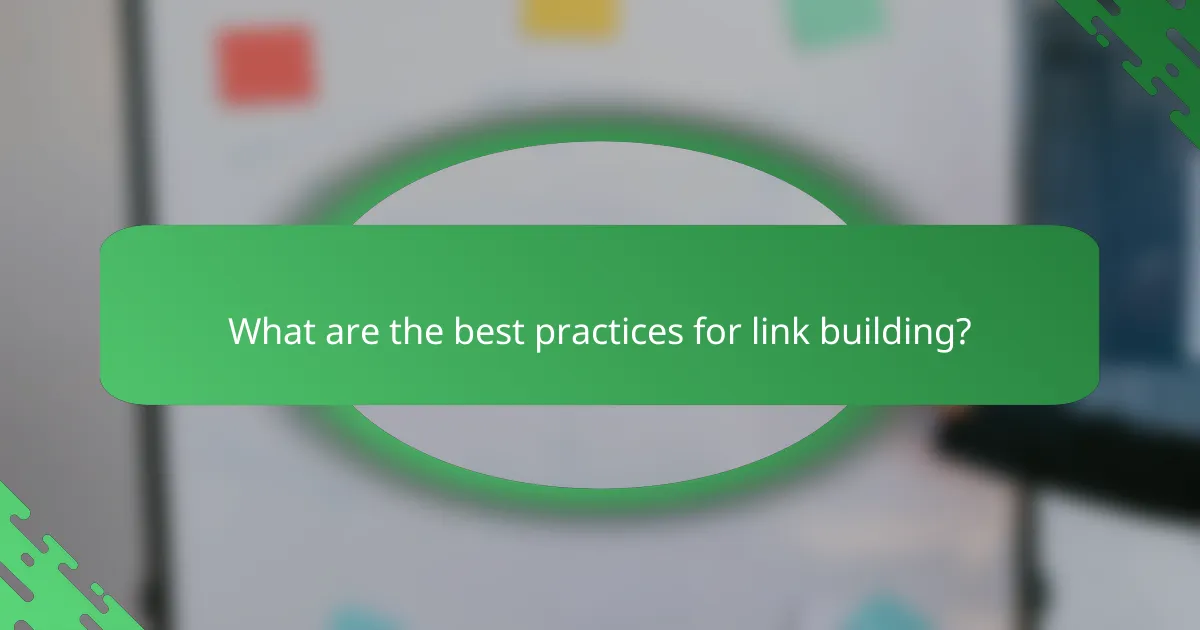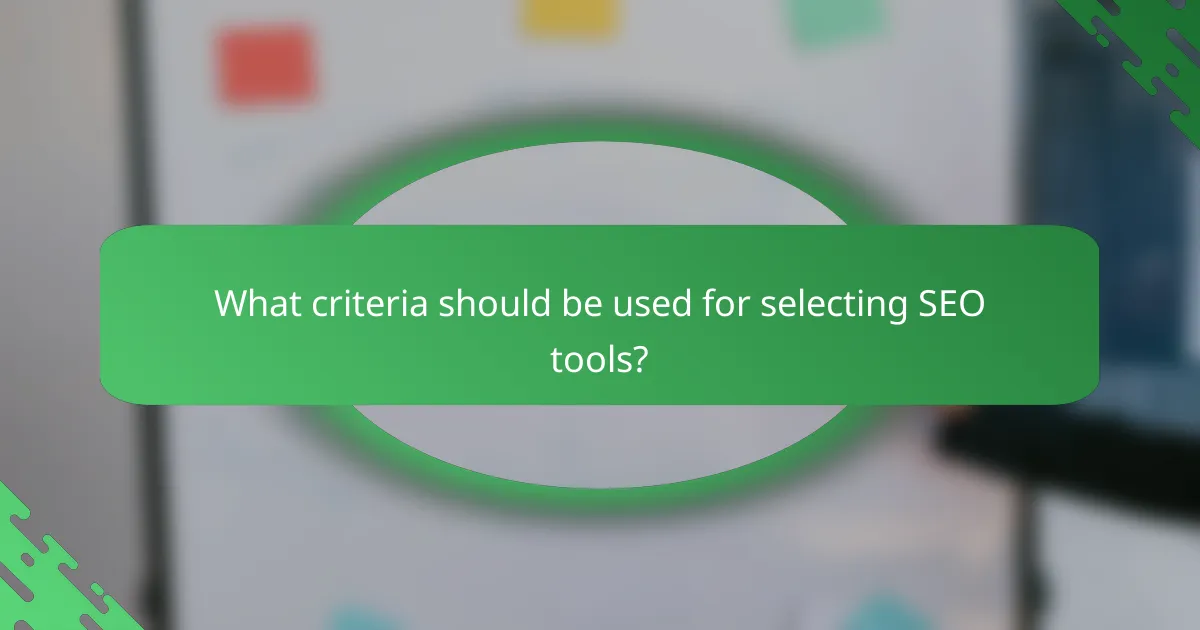Mastering SEO techniques is essential for improving your website’s visibility and attracting targeted traffic. Key components include thorough keyword research to identify relevant search terms, on-page optimization to enhance individual web pages, and effective link building to establish authority through high-quality backlinks. By implementing these strategies, you can significantly boost your site’s performance in search engine results.

What are effective SEO techniques for keyword research?
Effective SEO techniques for keyword research involve identifying relevant keywords that potential customers use in search engines. This process helps optimize content to improve visibility and attract targeted traffic.
Using Google Keyword Planner
Google Keyword Planner is a free tool that assists in discovering new keywords and estimating their search volume. By entering a seed keyword, users can generate a list of related keywords along with metrics like average monthly searches and competition levels.
To make the most of this tool, focus on keywords with a balance of high search volume and manageable competition. Aim for keywords that align closely with your content and target audience.
Analyzing competitor keywords
Analyzing competitor keywords involves examining the keywords that your competitors rank for in search results. This can reveal gaps in your own keyword strategy and highlight opportunities for content creation.
Use tools like Ahrefs or Moz to identify which keywords drive traffic to competitor websites. Look for keywords that have high search volume but low competition to gain an edge in your niche.
Utilizing SEMrush for insights
SEMrush is a comprehensive SEO tool that provides detailed insights into keyword performance. It allows users to track keyword rankings, analyze competitors, and explore keyword variations.
Leverage SEMrush’s Keyword Magic Tool to find long-tail keywords and related phrases. This can help you expand your keyword list and target specific queries that potential customers may use.
Long-tail keyword strategies
Long-tail keywords are phrases that are typically three or more words long and are more specific than general keywords. These keywords often have lower search volume but higher conversion rates due to their specificity.
Incorporate long-tail keywords into your content to target niche audiences. For example, instead of targeting “shoes,” consider “best running shoes for flat feet.” This approach can help attract users who are further along in the buying process.
Leveraging user intent
Understanding user intent is crucial for effective keyword research. User intent refers to the reason behind a search query, which can be informational, navigational, or transactional.
Align your keyword strategy with user intent by categorizing keywords based on their purpose. For instance, use informational keywords for blog posts and transactional keywords for product pages. This alignment can enhance user experience and improve conversion rates.

How does on-page optimization improve SEO?
On-page optimization enhances SEO by refining individual web pages to rank higher and earn more relevant traffic in search engines. This involves adjusting various elements like content, HTML tags, and site performance to align with user intent and search algorithms.
Optimizing title tags and meta descriptions
Title tags and meta descriptions are crucial for on-page SEO as they provide search engines and users with a summary of the page content. A well-crafted title tag should be concise, typically between 50-60 characters, and include primary keywords. Meta descriptions, while not a direct ranking factor, should be compelling and around 150-160 characters to encourage click-throughs.
To optimize these elements, ensure they accurately reflect the content of the page and include relevant keywords without keyword stuffing. Regularly reviewing and updating these tags can significantly improve visibility and engagement.
Enhancing content quality and relevance
High-quality, relevant content is essential for effective on-page optimization. This means creating content that answers user queries, is well-structured, and provides value. Aim for a word count that adequately covers the topic, often in the range of 1,000 to 2,000 words, depending on the subject matter.
Incorporate keywords naturally throughout the text, including in headings and subheadings, while maintaining readability. Regularly updating content to reflect current information and trends can also boost relevance and user engagement.
Implementing header tags effectively
Header tags (H1, H2, H3, etc.) help structure content and improve readability, which is beneficial for both users and search engines. The H1 tag should clearly indicate the main topic of the page, while H2 and H3 tags can be used to break down content into manageable sections.
Use header tags to include keywords and phrases that align with user search intent. This not only enhances SEO but also makes it easier for readers to navigate the content, improving overall user experience.
Improving site speed and mobile-friendliness
Site speed and mobile-friendliness are critical factors in on-page optimization that affect user experience and search rankings. Aim for a page load time of under three seconds, as slower sites can lead to higher bounce rates. Tools like Google PageSpeed Insights can help identify areas for improvement.
Ensure your website is responsive, meaning it adjusts seamlessly to different screen sizes. This is essential as mobile traffic continues to grow. Implementing best practices such as compressing images, leveraging browser caching, and minimizing JavaScript can enhance both speed and mobile usability.

What are the best practices for link building?
The best practices for link building focus on acquiring high-quality backlinks that enhance your website’s authority and visibility. Effective strategies include guest blogging, creating shareable content, utilizing broken links, and engaging on social media platforms.
Guest blogging on reputable sites
Guest blogging involves writing articles for other websites in your niche, allowing you to include backlinks to your own site. This not only drives traffic but also builds your credibility within the industry. Aim for reputable sites with a strong domain authority to maximize the impact of your links.
When selecting sites for guest blogging, consider their audience and relevance to your content. A well-placed guest post can lead to significant referral traffic and improved search rankings.
Creating shareable infographics
Infographics are visually engaging and can simplify complex information, making them highly shareable. By creating informative infographics related to your niche, you can encourage other websites to link back to your content as a source. Ensure your infographics are well-designed and provide valuable insights.
Promote your infographics through social media and outreach to bloggers and influencers who might find them useful. This can significantly increase your chances of earning backlinks.
Utilizing broken link building
Broken link building involves finding broken links on other websites and suggesting your content as a replacement. This technique helps webmasters fix their broken links while providing you with a valuable backlink. Use tools like Check My Links or Ahrefs to identify broken links in your niche.
When reaching out, be polite and concise. Explain how your content can serve as a suitable replacement and include a link to your resource. This approach can yield high-quality backlinks with minimal effort.
Engaging in social media outreach
Social media outreach is a powerful way to promote your content and build relationships with influencers and potential link partners. Share your articles, infographics, and other resources on platforms like Twitter, LinkedIn, and Facebook to increase visibility.
Engage with your audience by responding to comments and participating in discussions. Building a network on social media can lead to organic backlinks as others share your content within their networks.

What criteria should be used for selecting SEO tools?
When selecting SEO tools, focus on user interface, data accuracy, and integration capabilities. These criteria ensure that the tools you choose will effectively support your SEO strategy and enhance your workflow.
Evaluating user interface and ease of use
A user-friendly interface is crucial for maximizing productivity with SEO tools. Look for tools that offer intuitive navigation, clear labeling, and helpful tutorials or documentation. This can significantly reduce the learning curve and allow you to focus on implementing SEO strategies rather than struggling with the software.
Consider tools that provide customizable dashboards or reports, which can help you visualize data in a way that suits your needs. A good user interface should also be responsive and accessible across devices, ensuring you can work efficiently from anywhere.
Assessing data accuracy and depth
Data accuracy is vital for making informed SEO decisions. Choose tools that source data from reputable platforms and provide transparent methodologies for their metrics. Look for features like keyword volume estimates, competition analysis, and SERP tracking to gauge the depth of data offered.
It’s beneficial to cross-reference data from multiple tools to verify accuracy. Tools that offer historical data trends can also provide insights into seasonal fluctuations and long-term performance, which are essential for strategic planning.
Considering integration capabilities
Integration capabilities allow SEO tools to work seamlessly with other software you may be using, such as content management systems or analytics platforms. Look for tools that offer APIs or built-in integrations with popular services like Google Analytics, SEMrush, or social media platforms.
Effective integration can streamline your workflow, enabling you to consolidate data and automate reporting. This can save time and reduce the risk of errors that come from manual data entry, ultimately enhancing your overall SEO efforts.

How can local SEO techniques enhance visibility in the US?
Local SEO techniques are essential for businesses in the US to improve their online visibility and attract nearby customers. By optimizing for local search queries, businesses can appear in relevant local results, increasing foot traffic and online engagement.
Keyword Research for Local SEO
Effective keyword research for local SEO involves identifying search terms that potential customers use when looking for services in their area. Focus on long-tail keywords that include geographic locations, such as “best pizza in New York” or “plumber near me.” Tools like Google Keyword Planner or local search trends can help pinpoint these keywords.
Consider the intent behind the keywords. Users searching for local services often have immediate needs, so targeting phrases that indicate urgency can be beneficial. Regularly updating your keyword list based on seasonal trends or local events can keep your content relevant.
On-Page Optimization for Local SEO
On-page optimization for local SEO includes incorporating local keywords into key areas of your website, such as titles, headers, and meta descriptions. Ensure your business name, address, and phone number (NAP) are consistent across all pages and match your Google My Business listing.
Adding location-specific content, such as blog posts about local events or community involvement, can enhance relevance. Use schema markup to help search engines understand your business’s location and services, which can improve your chances of appearing in local search results.
Link Building for Local SEO
Link building for local SEO focuses on acquiring backlinks from other local businesses, organizations, or community websites. Collaborating with local influencers or participating in community events can help generate valuable links. Ensure that these links come from reputable sources to enhance your site’s authority.
Consider creating local content that is shareable, such as guides or resources relevant to your community. Engaging with local directories and review sites can also provide opportunities for backlinks while improving your online reputation.
